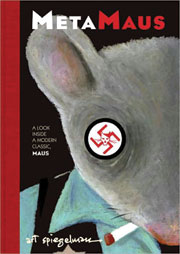“Metamaus: A Look inside a Modern Classic” by Art Spiegelman (Pantheon, 2011) $35 (Book and DVD) When Art Spiegelman began publishing “Maus” 25 years ago, reactions from the reading public ranged from praise to approbation. Imagine, telling the story of his father’s experiences in the Holocaust as a comic book and representing Jews as mice, the Poles as pigs, and the Nazis as cats? What was this avant-garde creator of comic literature trying to? In time, particularly after the author won the 1992 Special Pulitzer Prize Award, and numerous other prestigious honors, “Maus” became recognized as a 20th century classic. Spiegelman brought the graphic novel into the forefront of literature where today graphic literature is taken seriously by critics, educators and parents, as well as by readers of all ages.
When Art Spiegelman began publishing “Maus” 25 years ago, reactions from the reading public ranged from praise to approbation. Imagine, telling the story of his father’s experiences in the Holocaust as a comic book and representing Jews as mice, the Poles as pigs, and the Nazis as cats? What was this avant-garde creator of comic literature trying to? In time, particularly after the author won the 1992 Special Pulitzer Prize Award, and numerous other prestigious honors, “Maus” became recognized as a 20th century classic. Spiegelman brought the graphic novel into the forefront of literature where today graphic literature is taken seriously by critics, educators and parents, as well as by readers of all ages.
Now he gives his readers “Metamaus.” This beautifully-produced book is an examination of the original “Maus” and the author’s attempt to explain why he created the book and why he used the techniques he did.
Part One, entitled “Why the Holocaust,” explains to the readers why Spiegelman had to, if not exorcise, then to understand the nightmares of his childhood growing up as the child of survivors. In creating “Maus,” the author exhaustively researched everything related to his parents’ lives. If he were going to draw the latrines at Auschwitz, he made certain that his toilets looked exactly like the ones his father Vladek used. The shoes on his father’s feet were replicas of those in an old Polish shoe repair manual. He read obsessively. He made several trips to Poland and visited Auschwitz/Birkenau. Nothing was taken for granted.
In Part Two, Spiegelman discusses why he used mice to represent the Jews. Among other things, he drew some of his inspiration from Nazi posters of the 1930s that vilified Jews. And later when “Maus” was translated in German and Polish, the Germans were more accepting of their depiction as murderous cats than were the Poles who strongly protested their depiction as pigs.
Part Three of “Metamaus” explains the artist’s techniques. Readers come to understand that the placement of every frame has significance. In addition, there are interviews with his wife and children and a complete transcript of the interviews he had with his father over the years. The text is interspersed with photographs of his family, other comics that inspired him, as well as the first, second and third attempts to draw a particular episode.
This monumental work is a breathtaking homage to Spiegelman’s parents and family. It is an elegant examination of the creative artist at work. And most of all it is a moving reminder of the Holocaust and its victims and a tribute to those who managed to survive.
Andrea Kempf is a retired librarian who speaks throughout the community on various topics related to books and reading.


